| Architectural History |
The castle was erected between 1200
and 1609 in five periods or phases of construction, and by no means,
as often claimed, newly constructed by Jörg Scheck vom Wald by 1429. |
|
|
|
1st Phase of
construction (around 1200) |
Judging by the
brickwork, made from
block-shaped stones partially arranged like fish-bones and
seaming lines, the castle today features almost the same dimensions
and shape as it did from the first time it was constructed. These
types of arrangements of the bricks appear at the plinth of almost all
buildings.
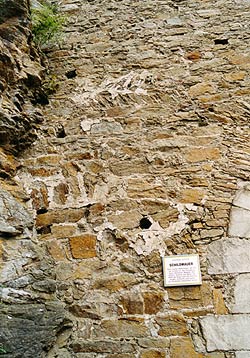 |
The old wall fragments
found at the dungeon area and at the corner of the outer gate,
suggest that the castle complex displays a similar extension to
the one built on the eastern side, around 1429. On site,
findings suggest that even then at least two external gates
existed. The outer gate found in place of today’s external gate,
the inner gate in place of the heraldry gate, where an
old brick fragment becomes evident. To the front of both gates
short access ditches, so called neck ditches, cut through the
compact mount. |
A historic illustration from 1542
substantiates the fact that an expanded Outer Bailey (“Vorburg”)
extends into the hillside situated to the front of the outer gate.
Both belays of the “Bürgel” and “Stein” were initially overhauled in a
similar way as later. From the castellological point of view, the 50 m
long hall extending along the southern side of the courtyard, is the
most important building of the castle. Situated on the “Bürgel” was an
angular low Fortified House, whereas the “Stein” comprises a similarly
dimensioned Large Hall (“Palas”), a slightly larger chapel and the
longer Maidens’ Tower („Frauenturm”). |
|
|
| 2nd
Phase of construction (around 1300) |
The extensive restorations done to
the brickwork around 1300 show the alleged destruction of Aggstein
Castle by Duke Albrecht I. (1295/96) with the following subsequent
restoration. Extremely extensive restoration work was done to the
southern wall and the attached hall building. The old wall plinth and
the walls foundations were used as substruction, with the exception of
the Maidens’ Tower (“Frauenturm”) where the completion of the western
side was relegated. The Palas obtained an interior wall and an “abort
jutty” (“Aborterker”) alongside the nose (“Felsnadel” of the later
known „Rosengärtlein“).
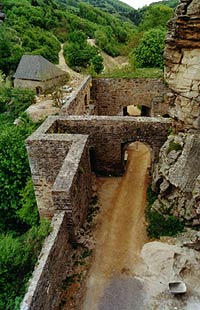 |
As an additional gate yard was inserted between the outer and
inner gates, the eastern corner between “Bürgel” and the
southern ring wall were blocked by a short traverse, the
reinforcement and the fortification of the castle are considered
to be the only two completely new architectural works.
|
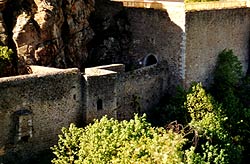 |
|
|
|
| 3rd
Phase of construction (1429-36) |
The construction between 1429 and 1436 hardly
becomes apparent in the masonry as it very much resembles the
brickwork of the 2nd phase of construction. Distinctive features
include the whitish sandstones in the corners and openings as well as
the double relief arches. Even though the castle fundamentally
remained the same, substantial extensions were made.
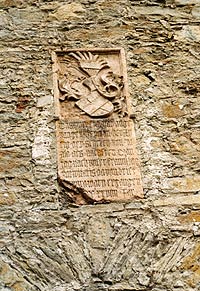 |
Massive walls, so called “shield walls” which were
several metres thick were constructed on the eastern side of the
castle, where cannons approaching from the hilly terrain proved to be
an increasing danger.
The access had to be protected at selected points, especially at the
1st and 3rd gate. The
„Bürgel“ was also reinforced by a bow-shaped encircling wall
on the eastern base of the rock and by an offside extension towards
the western side. A small building – which has almost completely
disappeared until today – was put on the southern wall, presumably
ending in the area of the later “Gate of the Well”. |
Even the adjacent great hall in the western part
underwent considerable modifications. Wide arched window chambers with
large windows were incorporated, a new inner wall was erected and a
new vault cellar was created.
Considerable modifications were also made to the hall building
adjacent to the western part of the hall. Vaulting underneath the
great hall, broad, arched chambers with large windows were
incorporated. The erection of a new inner wall and the creation of a
new vault cellar, also form part of these modifications.
A kitchen with a pyramid-shaped stone chimney and a semi-detached
house for the courtiers (“Dürnitz”) were built opposite the great
hall. The front side of the “Stein” facing the courtyard was changed
in a spectacular way to make the passage of way through the entrance
more difficult. This was done by raising the doorway and by
constructing a drawbridge and a machicolation.
The adjacent „Maidens’ Tower“ received two more storeys as well as
internal partition walls set on flying arches. The chapel as well as
the great hall were also heightened and endowed with new openings.
Finally the pinacle was converted into the „garden of the roses“ (“Rosengärtlein”)
by erecting a wall on top of it. |
|
|
| 4th
Phase of Construction (1531 sqq.) |
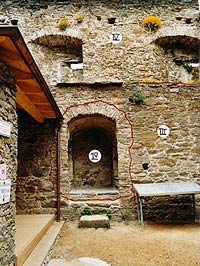 |
Ferdinand improved and fortified the vulnerable eastern
front by building a new wall walk with arched recess for wide-mouthed
gun ports. The longish northern façade was fitted with a flanking
defence bay and the gap between the 2nd and 3rd gateway was closed by
a crenellated wall. The small building situated in the middle of the
castle towards the south just beneath the “Bürgel” (cf. 3rd phase of
construction ) was demolished and replaced by the well tower
(“Brunnenturm”) and the Bakery (mistakenly called “smithy”) which
still exist today. The great hall was extended westwards until it
reached the “Stein” and fitted with several jutties. |
|
The “Stein” also underwent minor transformations, these
included: the flying arches in the “Maidens’ Tower” were barricaded,
massive wooden stairs, a wooden and several privies were incorporated,
the curtain wall was extended by a new wall walk
(“Wehrgang”) which had windows and a privy. At the foot of the
wall he built a small vault, he even changed the chapel to bulge
inwards and integrated windows into it. |
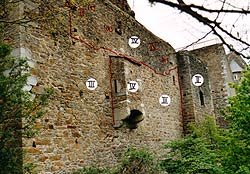 |
|
|
|
| 5th
Phase of construction (1609 sqq.) |
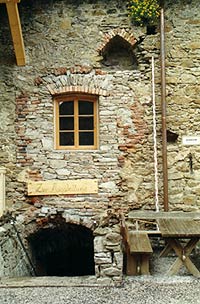 |
In this phase of construction the great hall was
converted into an administration building (“Kanzleibau”). The original
openings were barricaded, new openings were hammered out and the
cellar was made accessible by a flight of winding stairs. The parlour
for the gatekeeper behind the 1st gateway was a completely new
construction as well as both of the houses in the outer castle. |
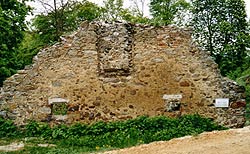 |
|
|
|
| 6th
Phase of construction (19th, 20th century,
early 21st century) |
Various restorations such as the
filling of the trenches and the reconstruction of the kitchen and
house for the courtiers (“Dürnitz”), done in 1819, 1901 und 1922,
depict the fifth phase of construction.
Further renovations concurred in 1945 sqq. as well as in the early
1970ies. It was not until 2004 that comprehensive restorations and
revitalisations were carried out by covering and restoring the great
hall and integrating new lavatories. The vaulted cellars
(“Gewölbekeller”) underneath the great hall were refurbished and the
wooden staircase leading to the “Stein” and “Bürgel” was revamped. A
look out point was built on top of the 3rd tower. The
chapel was revamped with great effort and the gatekeeper’s parlour,
built in the 17th century, was used a little souvenir shop |







